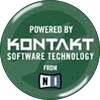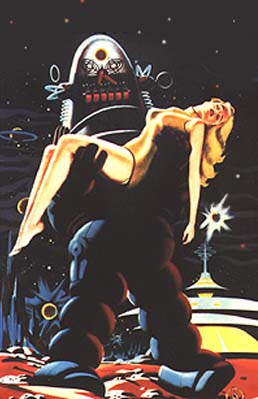|
Nostalgia demo 1
Nostalgia demo 2


|
 |
More than any other period
of the last century, the '50s was probably the decade that introduced
the world to the concept of electronic sound and electronic music
through its usage in the emerging genre of sci-fi films.
Prior to this, few people had really heard electronic
music and its use in soundtracks was limited to a few eerie chords
played on a Hammond or possibly the occasional use of a Theremin
or perhaps Ondes Martenot.
During the '50s, however, more and more use was made
of electronics to produce effects and sounds for this new breed
of entertainment. Of course, a lot of it was very unsubtle use of
the Theremin and, of course, many of the films were rather shabby
'schlock-horror' B-movies.
But one movie stands out from the crowd and that is
"Forbidden Planet".
Released in 1956, "Forbidden Planet" was loosely
based on Shakepeare's play, "The Tempest". The story takes
place in the far future with the crew of the United Planets cruiser
C-57D on a mission to Altair IV in search of survivors from
a previous expedition. Much like the lost island of the original
play that is buzzing with the spirit of the faeries, the landscape
of Altair IV is alive with strange extra-terrestrial mystery. On
the planet, the crew of the rescue ship encounters the mysterious
Dr Morbius and his beautiful daughter Altaira, the only remaining
survivors of the spaceship Bellerophon which had landed on
the planet twenty years earlier. |
Morbius shows the crew of the
rescue mission the advanced technology left behind by the now extinct
Krell who once inhabited the planet. Morbius has been using this
technology to expand his intellectual powers but in doing so, has
released a monster (the 'ID'), an invisible manifestion of the dark
side of the doctor's mind. The crew of the C-57D must battle to
save themselves and escape the planet. It is dark and sinister but
as light relief, there is Robby the robot (above), a modern-day
equivalent of Caliban from the original play.
It's a marvellous film with special visual effects that
were extremely advanced for the time. However, the soundtrack was
of particular special interest. |
| Created by Louis and Bebe Barron,
a husband and wife team based in New York, "Forbidden Planet"
was the first movie to have a totally electronic soundtrack AND
it was credited as such ... as 'Electronic Tonalities' ... and it
was to be a major influence on the use of electronic music in the
movie industry for years to come.... even to this day! This was
not an orchestral score with some gratuitous Theremin thrown in
as an afterthought - for the first time in the history of movies,
here was a totally electronic music soundtrack that was an integral
part of the film and hearing these compositions for the first time
must have been a truly 'out-of-this-world' experience for most people
at the time.
But, of course, the film was made almost a decade before
Robert Moog would show his protoype synth modules at a trade show!
So what did the Barrons use to realise this innovative soundtrack?
In a time before commercially available synthesisers
were available, the Barrons designed and constructed their own circuits.
They didn't build a synthesiser as such... instead they built circuits
with particular sounds in mind. |
|
They would view the footage or read the
screenplay and discuss the kind of sounds or atmospheres that were
required for the characters or the scenes and between them. They
would set about building the circuits required for the job. |
 |
They described their circuits
as 'non-linear' and they tried to imbue their designs with an 'organic'
quality but the process was subject to serendipity - that is, their
circuits had flaws and imperfections and didn't always behave as
expected.
However, if anything, this was a strength that the Barrons
exploited to highlight the human flaws in the characters or, indeed,
the unpredictability of an alien landscape.
These sounds would then have been recorded with tape
delays, spring reverbs and other (primitive) processing and the
whole collage would then be assembled using intricate tape splicing
techniques. |
The Barrons were undisputably at the vanguard of early
electronic music and we owe them much. Apart from "Forbidden
Planet", they also contributed their talent to many other (less
well known) films as well as making their studio available to pioneers
of the time such as John Cage and others. If nothing else, their
work on "Forbidden Planet" contributed towards putting
seriously constructed electronic music into the mainstream of public
acceptance. The couple divorced but still continued to work together.
Sadly, Louis died in 1989 but the last thing I heard was that Bebe
(now 77!) is still active in the field.
"But what has any of this to do with this website?"
you ask. Well......
I have long been using Native Instruments' REAKTOR to
design and build my own 'circuits' in software in a similar vein
to the Barrons' ethos - to create 'organic' instruments that can
generate eerie soundscapes almost at random and which have an unpredictable
life of their own. On offer here is a collection of samples from
these instruments. Although the technology is thoroughly modern,
the sounds themselves don't come more 'vintage' than these!!
I make no claim that any of the sci-fi samples in Nostalgia
are authentic recreations of the Barrons' work but a close friend
of Bebe Barron says that they are "Very much in the spirit
of Forbidden Planet, and in most cases dead ringers for the original"!
All the sounds are single samples recorded at C3 but
mapped out from C1-C6. As a result, they will speed up and slow
down if played across the keyboard range. However, this is perfectly
in keeping with the Barrons' original work who used different tape
speeds to affect the playback of their recordings.
The 'landscapes' are stereo whilst the rest are mono.
All have been sampled with primitive reverbs and delays appropriate
to the era. |
If you'd like to hear the Barrons' original work, the
soundtrack for "Forbidden Planet" is available on CD at
Amazon |
|

